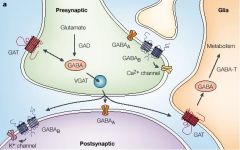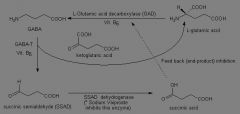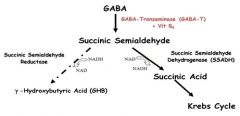![]()
![]()
![]()
Use LEFT and RIGHT arrow keys to navigate between flashcards;
Use UP and DOWN arrow keys to flip the card;
H to show hint;
A reads text to speech;
24 Cards in this Set
- Front
- Back

1. Explain GABAergic neurotransmission using a diagram including receptors, enzymes, pathways and specific locations (i.e. where is GABA-T located?)
|
b. GABA is not in a vessicle to begin with – just highlighting it… VGAT – transports it into the vessicle. Ca++ influx stimulates release of GABA from vessicle into the synaptic junction. It can bind to the GABA receptors post synaptically or presynaptically.
c. There are GABAa and GABAb receptors. d. If it binds to post synaptic receptors it provokes inhibitory response. If it binds to presynaptic recetpors it causes auto inhibition (it stops releaseing GABA) This is a type of negative feedback. e. Besides the GABA a and b receptors there are GABA transporters (GAT) – on astrocytes of glial cells and on presynaptic neuron. Some amount of GABA goes back into the presyaptic neuron àGABA-T is floating around in CYTOSOL (inside cell not synapse) and breaks down GABA. Done the same way in the Glial cells. f. Some amount of GABA is degraded by GABA-T before it is even released, but some is released. Only some GABA that comes in via GAT is degraded by GABA-T – some goes and is rereleased. |
|
|
Draw/viz the steps involved in the biosynthesis of GABA?
|

a. Glutamate is transformed into GABA via Glutamic Acid Decarboxylase (GAD) + Vit B6
b. Synthesized in the cytosol of the neuron |
|
|
3. Draw/viz the metabolism of GABA and its role in krebs cycle.
|

GABA--(GAT+B6)-->SSAD
SSAD--(SSAD DH)-->Succinate Succinate --> CAC |
|
|
4. What are the two major types of GABA Receptors?
|
a. GABA-a: Cl- ion channel = hyperpolerization
b. GABA-b: Gi coupled receptor --> Ca++ blk and K+ potentiate Modulates ADENYLYL CYCLASE signal & blocks Ca++ channel on that neuron AND facilitates opening of K+ ion channels (which moves out of the cell) = hyperpolarization |
|
|
5. Understand the MOA of Benzodiazepines and their actions.
|
a. Benzos bind to benzodiazepine site of the GABA-a complex to increase the FREQUENCY of chloride channel openings and thus increase inhibition. Cuases small hyperpolarization that inhibits formation of action potential.
|
|
|
6. What is the difference in therepy with Flurazepam Vs Triazolam?
|
a. Flurazepam has a fast onset of action. VERY LONG ½ life and is used in short term treatment of insomnia (F=FAST)
b. Triazolam has an intermediate onset of action, much shorter ½ life and is used for short term treatment of insomnia (opposite of long triathalon) |
|
|
7. Understand the mechanism of action of BARBITURATES
|
a. Bind to the GABA-a receptor at the alpha subunit, which are binding sites distinct from GABA itself and distinct from benzos.
b. They can open Cl- channels themselves (mimicking GABA – without GABA present) they also act by increasing the LENGTH OF TIME the chloride ion channel remains open. c. Also block the AMA receptor, a subtype of glutamate receptor |
|
|
8. Know the names of the top 200 drugs used as anxiolytics, sedatives/hypnotics.
|
a. Buspirone (BuSpar)
b. Zolpidem (Ambien) c. Eczopiclone |
|
|
9. What are the therapeutic uses of barbiturates?
|
a. Anesthesia (and euthanasia)
--Ultra-short acting (Thiopental) used for anesthesia b. Sedative/hypnotic --Short acting (Secobarbital) used as sedative/hypnotic c. Anticonvulsant --Long acting (Phenobarbital), used to treat seizures |
|
|
11. Know the possible MOA of Buspirone and Chloral hydrate.
|
a. Buspirone:
i. Has a high affinity for 5HT1A and 5HT2 receptors and moderate affinity for DA2 receptors b. Chloral hydrate i. Trichlorinated derivative of acetaldehyde converted to its active metabolite, tricholorethanol - synergizes with ethanol |
|
|
12. Understand the use of Flumazenil as a benzodiazepine antagonist.
|
a. Reverses sedative effects of benzodiazepines used in conscious sedation and general anesthesia; treatment of benzodiazepine overdose.
|
|
|
13. What is the definition of Insomnia?
|
i. Difficulty falling asleep
ii. Difficulty remaining asleep iii. Awakening too early iv. A sense of non-refreshing sleep |
|
|
14. What is insomnia pharmacotherapy targeted at?
|
a. Targeted based on indications: sleep onset or sleep maintenance
|
|
|
15. What is the MOA of the following sedative/hypnotics
a. Ramelteon b. Eszopiclone c. Zolpidem |
i. Selectively binds to the melatonin receptors in the suprachiasmatic nucleus (SCN),
ii. High affinity for melatonin MT1 and MT2 receptors b. Eszopiclone i. May interact with GABA-receptor complexes at binding domains located close to or allosterically coupled to benzodiazepine receptors ii. Benzodiazepine receptor agonist c. Zolpidem i. Zolpidem, an imidazopyridine hypnotic that is structurally dissimilar to benzodiazepines ii. Enhances the activity of the inhibitory neurotransmitter, γ-aminobutyric acid (GABA), via selective agonism at the benzodiazepine-1 (BZ1) receptor |
|
|
____ compete with GABA-modulin on the GABA receptor
|
BZPs - but they do not activate the modulin site --> leaving AS open for GABA to bind
REMEMBER THIS!!!! |
|
|
The difference between most sedatives and hypnotics is the____, not the drug
|
DOSAGE
|
|
|
What are the advantages of using long acting benzodiazepines?
|
less frequent dosing, but buildup is a con --used for chronic anxiety
|
|
|
What is the advantage of using short acting benzodiazepines?
|
fast onset, no buildup, but requires more frequent dosing, may lead to withdrawal --used for insomnia
|
|
|
What are the BZDs of choice in elderly or cirrhotic patients? Why?
|
Fllurazepam, oxazepam, lorazepam
b'c metab'd by glucuronidation which is less affected by aging and liver disease |
|
|
Name the BZD antagonist.
|
FLUMAZANIL
|
|
|
List the therapeutic use of barbiturates.
|
Anesthesia
--Ultra-short acting (Thiopental) used for anesthesia Sedative/Hypnotic --Short acting (Secobarbital) used as sedative/hypnotic Anticonvulsants --Long acting (Phenobarbital), used to treat seizures |
|
|
What receptors do Buspirone bind to?
|
5HT1A, -2, a little do DA D2 receptors and a-2 (Gi) in the brain
|
|
|
Why does Zolpidem have minimal anxiolytic, myorelaxant, and anticonvulsant properties?
|
It binds selectively to Benzo-1 receptor, all the other effects are from benz-2 receptor
|
|
|
10. Why are benzodiazepines used as anxiolytic/sedative/hypnotics over barbiturates?
|
ADR’s severe = don’t use for general anxiety
CNS effects --Drowsiness, CNS depression --Drug hangover --Hypnotic doses cause a feeling of tiredness well after the patient wakes --Nausea, dizziness Dependence --Withdrawal is severe Poisoning --Respiratory depression coupled with cardiovascular depression |

